Does The Gold Nugget Pleco Lose Color As It Grows?
For many pet lovers, Catfish certainly are a must in their aquarium.
The fact that Catfish are one of the virtually popular species of fish is evidence of their fascinating looks and distinct personalities. Whether you are a first-timer or a seasoned aquarium possessor, y'all can almost never go wrong past choosing Catfish equally the inhabitants of your aquarium.
In this guide, you volition get a detailed caption well-nigh 20 types of Catfish you lot tin can stock for your aquarium.
Some of these details include their life-bridge, feeding addiction, temperament, and how to care for them. This guide will be certain to help you brand an informed decision of the blazon of Catfish you desire.
That existence said, let us explore the options you lot may cull to become for when choosing an aquarium catfish.
Preliminary Considerations
Catfish take different lifespans and if well taken care of, may live for several years.
The Striped Raphael, for instance, may live for upwards to seven -fifteen years. Otocinclus and Banjos accept been known to alive for over 5 years, while the Pictus Catfish may live in your aquarium for nearly 8 years. You tin can await a Whiptail catfish and a Queen Pleco to live for more than x years.
Catfish mostly are easy to keep, but this may depend on the blazon of catfish it is
For example, while the Corydora does non demand much from its owner, a Ghost-fish requires constant care and attention. Besides, some species such as the Clown Pleco and Tiger-Shovelnose, need to take their water changed as constantly as every iii days.
When choosing a tank to house your catfish always pay attention to the size
This is because you want to ensure enough space for swimming and burrowing. Too, pay regard to the substrate and provide sand substrates for lesser feeders, while gravel may be suitable for armored catfish.
If you plan on having a community aquarium, always remember not to put smaller fish with other aggressive species or a larger species which might fault it for food.
Catfish may be herbivores, carnivores, or omnivores
Herbivores feed on algae wafers and flakes, driftwood, cucumbers, yams, squash, peas, and zucchinis.
Carnivores generally feed on meat-based feeds such every bit bloodworms, brine shrimps, common earthworms, and sometimes smaller fish. While omnivores may enjoy both a found and a meat-based diet, they generally tend to feed more on meat and less on plants.
All-time Freshwater Catfish for Fish Tank
Ghost Catfish
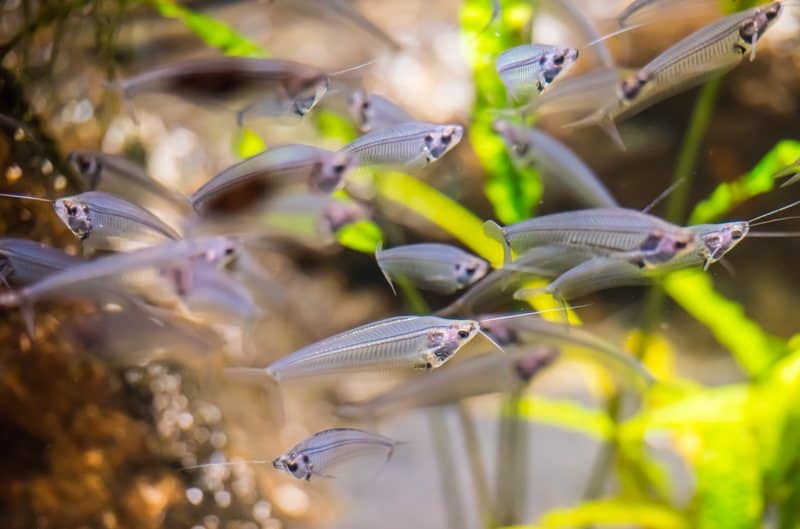
Ghost catfish are sometimes referred to as Glass catfish and are so named considering of their transparent flesh.
They generally prefer to stay in schools and like can often become reclusive or stressed when kept alone, thus information technology is appropriate that they are kept in schools of v-6 private fishes.
The ghost catfish is an omnivorous species and mostly prefers to stay in slightly acidic waters. It is important that they are handled with care considering they are vulnerable to diseases such as Ich.
Extra intendance must be taken in regards to their feeding as they hardly fight with competitors for nutrient and as such, they ofttimes starve when placed with other ambitious fish. The usual solution is to go on them in a single-specie aquarium.
Ghost catfish are a low-light species, i.e. they are most comfy in dark tanks. Nevertheless, this doesn't hateful that they are to be permanently and completely shut off from the light. Simply providing hiding places such as live plants or rocky caves should do the trick in that regard.
Upside-down Catfish

Named for its ability to swim and feed in an inverted position, the upside-downward catfish is a calm and gentle species that is sure to attract attention. Only like the Ghost catfish, the upside-down catfish is an omnivore and thus needs to have a plant and meat-based diet.
The upside-downwards catfish also prefers to stay in schools of up to half-dozen other fish of its species. Note though that this particular species thrives in well-planted tanks and by and large prefers wide-leafed plants.
Corydoras catfish
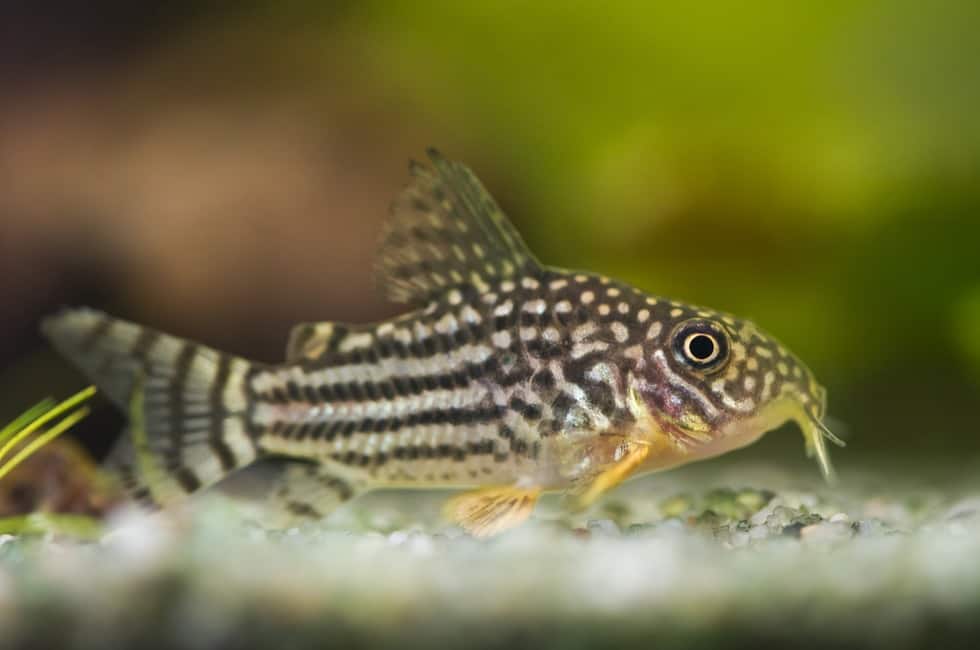
Cories are certainly one of the most sought-subsequently catfish in the world. This can be traced to the fact that they are easy to care for. All you demand to ensure is that this omnivorous has a found and meat-based nutrition, that it is kept in a school of 5-6 fishes, placed in water with a stable temperature, and that it is kept in an aquarium of a sand substrate.
Bristle nose Pleco
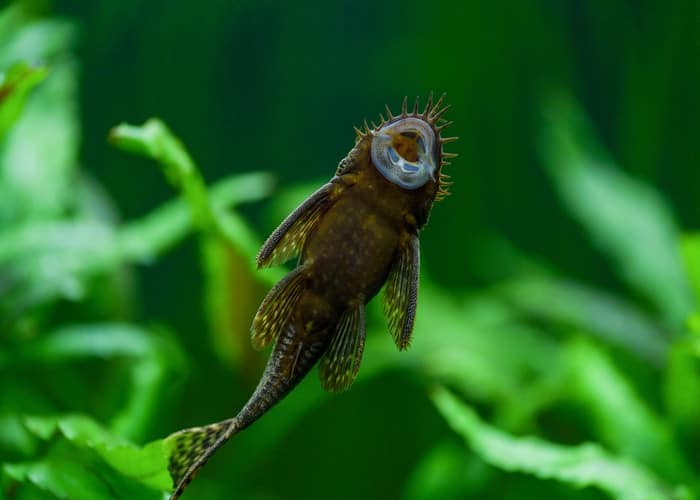
The bristle nose pleco is a relatively pocket-size catfish that grows upwards to three ½ inches in length and which spots a spiky growth on its nose. They are quite peaceful and would make a smashing addition to a community tank. The bristle olfactory organ is an immense algae eater and can adapt to a range of water temperatures.
You would do well to provide the fish with plenty of nutritious options such as zucchini, squash, and cucumbers. Algae wafers and other plant-based food would also make a smashing improver to your fish'due south menu.
The bristle nose is definitely ane fish you lot would want to add to your aquarium collection equally information technology is a groovy scavenger and can help continue your aquarium free of leftover nutrient.
Asian rock catfish
This small rocklike catfish is also known every bit the Hara Jerdoni. They are very minor, shy, and hardly undergo whatever activity except when kept among a school of upwardly to 4-5 fishes.
The Hara Jerdoni is a sensitive fish; thus, it is of import that its water condition is kept stable as a shift in temperature or even oxygen levels, can evidence to be dangerous. It is documented that they prefer sand substrate over the harsher stone and gravel. You would do well to provide alive foods such as blood worms and also a sand substrate instead of rock and gravel for this little dazzler.
Pictus Catfish
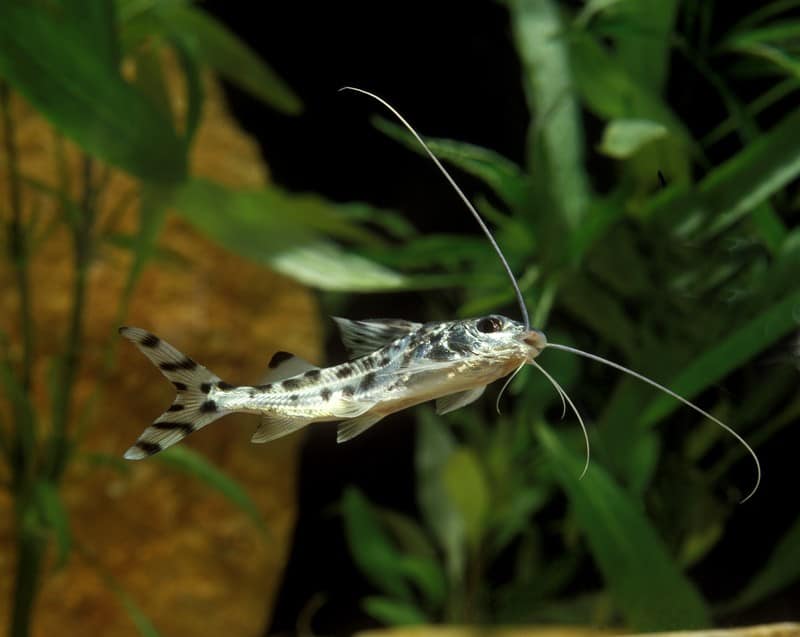
The Pictus Catfish is a nocturnal, medium-sized option that grows to a length of almost 11-12 inches. This fish may sometimes be ambitious and may feed on other smaller species. So, it is safer not to identify them in the same tank with smaller fishes. Putting them in a small school serves them simply as fine as being put alone. They mostly swallow fleck food or bloodworms and may occasionally feed on plants. Their immense whiskers are one of the highlights of this fish reaching all the way back to the caudal fin.
Please watch out for the spines on the dorsal and pectoral fins of this species, because these spines are poisonous and can cause quite a sting if they prick your skin.
Bumblebee Catfish
The black and yellow markings of this fish give it its name and fame. These peaceful fish hardly grow more than 3 inches in length. Despite beingness an omnivorous species, they are by and large very peaceful. Still, some accept been known to consume minor tank mates.
These fish prefer tanks with warmer temperatures within 73- 78 degrees. And so long equally their feeding is taken care of and they are kept with other peaceful only larger or equal sized fish, then you lot should have no trouble caring for them.
Clown Pleco

The clown pleco is a pocket-size fish that grows to near a maximum of iv inches. While it will munch at algae and fresh vegetables, this trivial clown is quite a sucker for driftwood. So, brand sure to go along driftwood ample in the aquarium.
The clown pleco is peaceful and can survive in a community aquarium so far equally there are no ambitious and bigger fishes around to gobble it up.
Gold Nugget Pleco
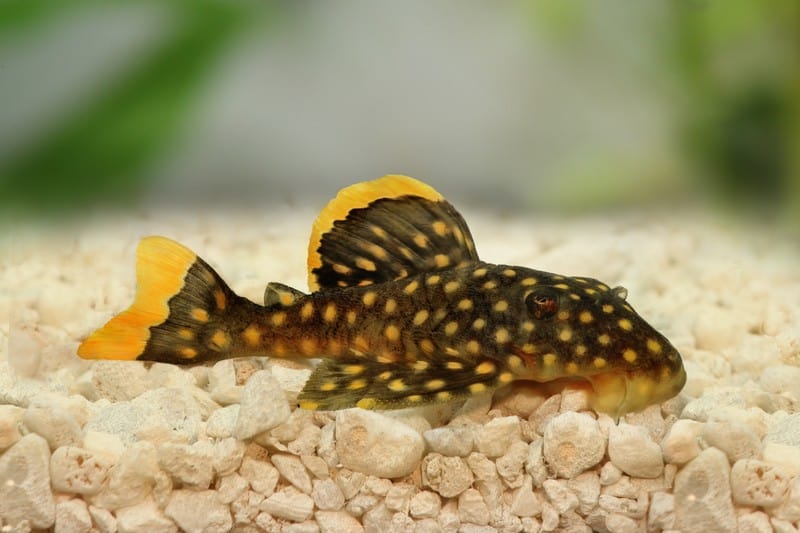
The Gold Nugget is a bigger cousin to the clown pleco as this fish can reach a length of up to 10 inches. The fish tin can exist recognized past its dark body with golden yellowish spots and markings along its dorsal fin.
The Nugget is an omnivore, then its diet should not constitute a trouble for you. Information technology can practise well on algae, vegetables, and meat-based sinking nutrient. This absolute dazzler is quite peaceful and certainly does get along well with neighbors.
Otocinclus Catfish
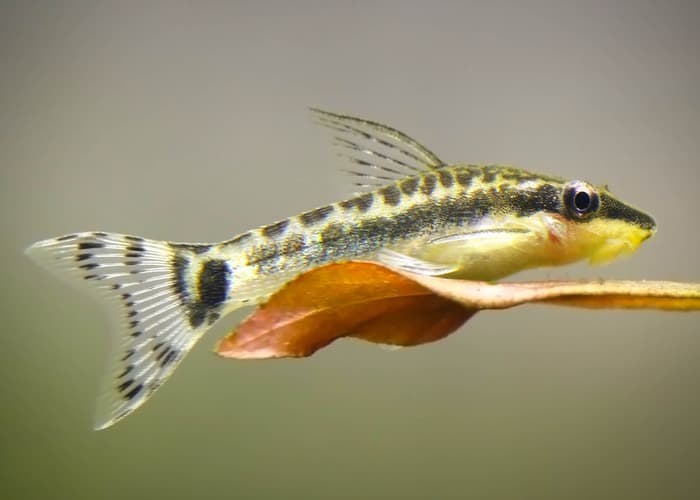
Algae eating, depression-cost maintenance, and easy-going; one can hands be lured into keeping an Otocinclus catfish. However, irrespective of its interesting features, at that place are certain things that might brand the Oto a challenge for beginners.
A heavily planted tank with lots of cover and hiding places is essential for keeping an Oto. Also, practiced h2o catamenia and quality must exist ensured before choosing an Oto. Other than these, the Oto is an excellent choice for your planted aquarium as they exercise not feed on your plants fifty-fifty while eating algae off them. They are also peaceful and will have no trouble with nonaggressive fishes.
The Striped Raphael
Otherwise known as the 'Talking fish', the Striped Raphael is an omnivorous fish that tin can reach ten inches in length. The strongest strength of this fish is that it can cope with a wide range of neighbors. This is because it is gentle and nonaggressive to weaker species in so far equally it does not mistake them for food. It can also certainly hold its own against more ambitious fish due to its big size and armored covering.
The Striped Raphael can exist kept in a small school just will also do fine past going solo. It is important though that they are kept in a large tank with the sandy substrate as they spend a lot of fourth dimension burrowing in the substrate.
The Queen Arabesque Pleco
With its majestic-looking arabesque patterned flesh, the Queen Pleco is indeed royalty. This beauty inappreciably grows more than than 4 inches in length. Aside from its stunning beauty, the Queen Pleco is distinct from other Plecos because information technology doesn't feed on algae. Rather, it is wholly carnivorous and prefers a meat-based diet.
Due to its gentle nature, it could be fatal to place this beauty in a tank containing other ambitious or larger fish. This pleco thrives in tanks with strong currents and regular h2o changes.
The Whiptail Catfish

The Whiptail Catfish is a species that grows to a fairly large length of about 6 inches. They are known to successfully blend in with their environment due to their tan or blackness colors. Although the Whiptail Catfish has a gentle temperament, it is not e'er a natural fit for a community tank. This is because a neutral water pH and well-aerated water with high quality are required to sustain them.
Then, if you must go on them in a community tank, please ensure that the other fish you continue have similar requirements for tank parameters. The Whiptail Catfish is an omnivore, and so they can survive on meat-based food and algae. Y'all should go along them in planted tanks with lots of hiding places so that they don't go stressed.
Walking Catfish
The Walking Catfish is an air-animate freshwater aquarium catfish. This species more often than not has a blackness colour but can also come in a pale flesh. They more often than not enjoy tanks that apply both an aquatic and terrestrial habitat. These fish can reach nearly a foot in length and will eat anything minor enough for information technology to swallow.
Due to their aggression, you would exist better off keeping it with but bigger fish. Due to their scaleless and mucus-coated pare, you should provide a fine substrate in their tank.
Banjo Catfish
With its flat head and a trunk that looks like a banjo, the Banjo Catfish is one of the easily recognizable catfish. Almost banjo catfish sold at pet stores reach a maximum size of 6 inches, but some accept been known to reach a length of ii feet.
This omnivorous species is a nocturnal feeder and then you had best make sure to put in some bloodworms and brine shrimps every night. The banjo is a nonaggressive fish and you can always put it in with smaller fish. A sand substrate is recommended for this species.
Spotted Raphael Catfish
This talking fish is a rather beautiful catfish. Its body could range from a blackness to night brown color patterned with an irregular minor spot that can range from vivid white to pale yellowish.
The Spotted Raphael Catfish is omnivorous and is not a fussy feeder. It is a bottom feeder that will consume any food that reaches it. The Spotted Raphael is a nocturnal feeder and, should be fed right before or after the lights are turned off on the aquarium.
FeatherFin Squeaker Catfish
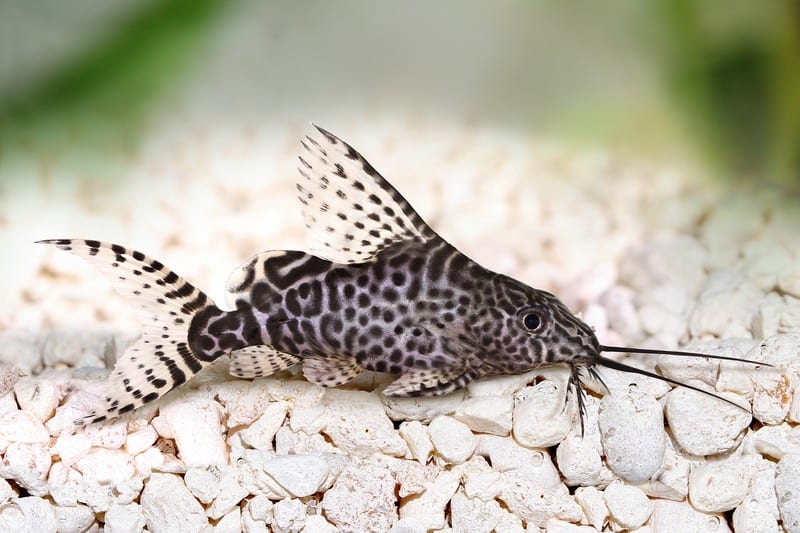
The Feather fin is a close relative of the upside-down catfish. It is an first-class choice as a when looking for an bonny and long-lasting bottom feeder. This species can survive singly or as part of a school. When kept singly they make a rather intriguing sight and are particularly active when feeding. This catfish prefers a tank with lots of hiding places, peculiarly driftwood. The substrate should be sand or polish gravel in order to lessen chances of barbel impairment
Featherfins are omnivores that have an appreciation for meaty foods and vegetables. Brine shrimp and blood worm are first-class snacks for the feather fin.
Irised Shark Catfish
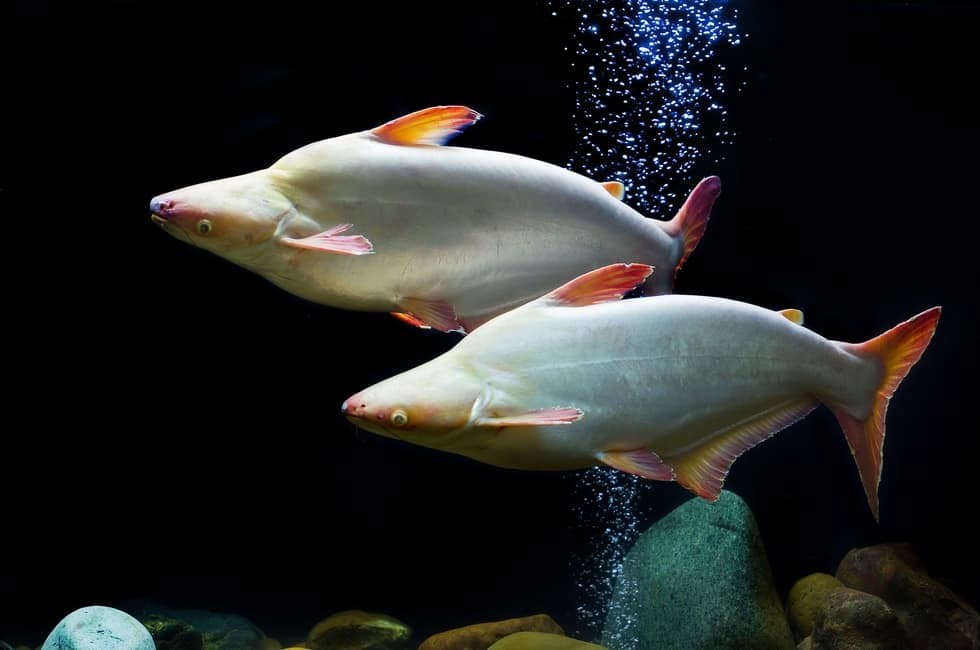
The iridescent catfish is a schooling catfish, whose name originates from its juvenile coloring and shark-like body shape. This catfish, though, is only recommended for very large aquariums such as a 300-gallon tank. Information technology has a peaceful temperament and can thrive well with other fish, as long as their tank mates are besides big to swallow.
The Iridescent Shark Catfish starts out as an omnivore and can eat anything that it can find. Equally they grow larger, they tend to swallow more alive and meaty foods. At some indicate though, they lose their teeth and may become increasingly herbivorous.
Tiger Shovelnose Catfish

The tiger catfish is a big catfish that tin can grow up to ii-three feet given the right sized tank, food, and water status. This aggressive omnivore is recommended but for experienced aquarium owners. It prefers to feed on meaty foods and large pellets. Tiger Catfish have very large mouths and tin easily eat small fish. They do, however, rarely eat their tank mates if kept well fed.
Tiger catfish are very agile and may easily hurt smaller fish with their energetic and active behavior. Due to their corybantic energy, they are reputed to accidentally jump out of their tanks, and then delight ensure that you fit its tank with a very secure chapeau. You as well would exercise well to place them in large tanks of upward to 400 gallons.
Zebra Pleco
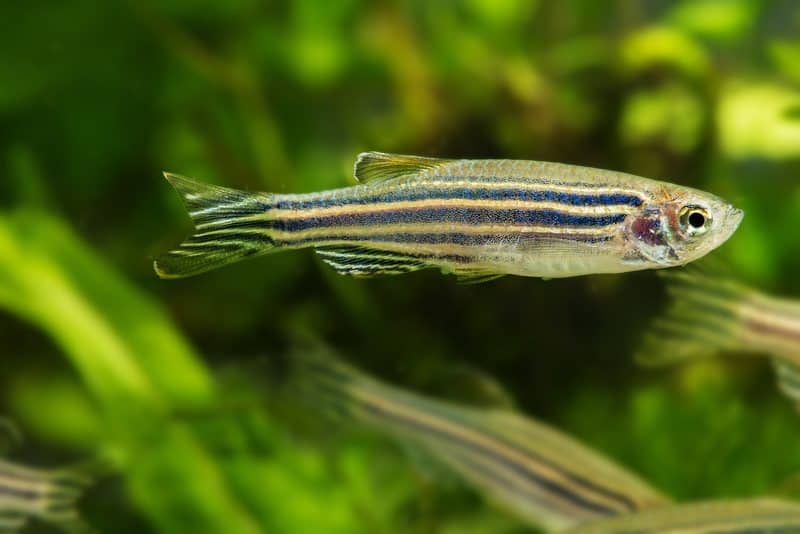
As its proper name suggests, this catfish is colored like a zebra with blackness and white stripes. This is a minor fish species that may grow up to a size of 10 cm. This fish is an omnivorous species and tin be fed with frozen and live food such as bloodworms or brine shrimp. They can too eat crushed peas and peeled zucchinis.
The fish has a gentle temperament and can do well with other not-aggressive species. They may, however, develop territorial and aggressive issues if kept with members of the same species. You should use sand or gravel for its aquarium. The tank should have many hiding spots and its water should be oft changed to keep it fresh and full of oxygen.
Does The Gold Nugget Pleco Lose Color As It Grows?,
Source: https://fishtankmaster.com/freshwater-catfish-for-aquarium/
Posted by: harkinsgratting.blogspot.com


0 Response to "Does The Gold Nugget Pleco Lose Color As It Grows?"
Post a Comment